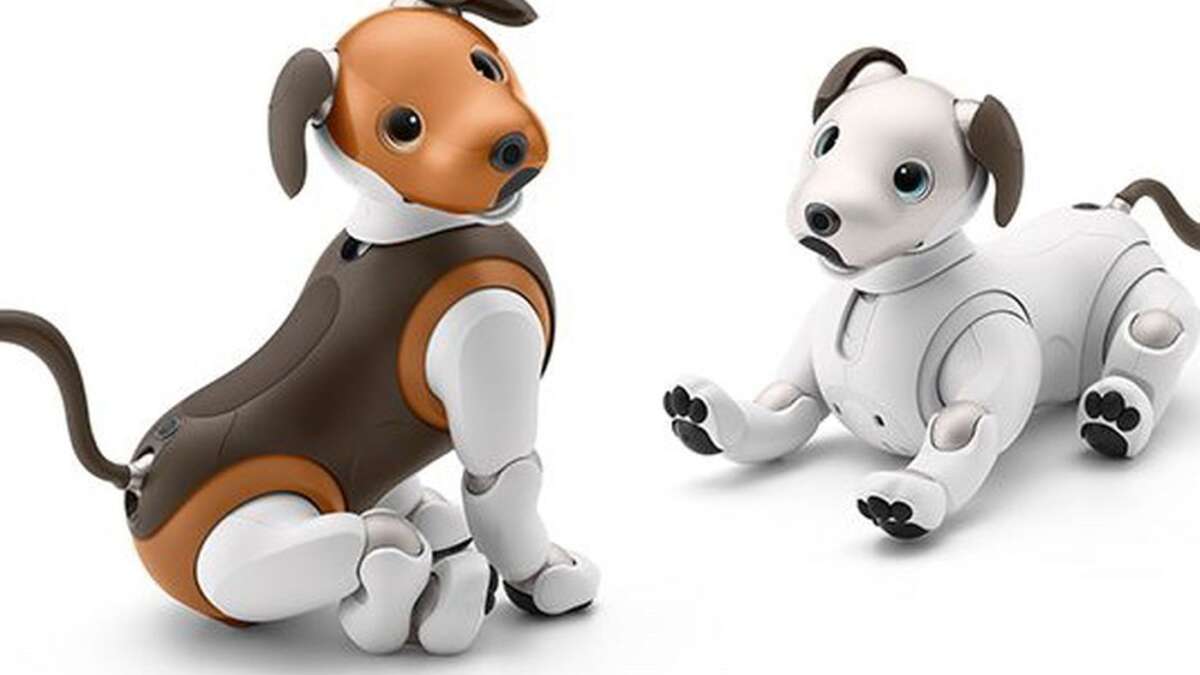Robotic dogs called AIBO are produced and designed by Sony. Midway through 1998, Sony revealed an Aibo prototype. On May 11, 1999, the first consumer version was unveiled. Up until 2006, new models were released each year. Even though dogs made up the majority of the models, lion cubs, huskies, Jack Russell terriers, bull terriers, and space explorers were also used as models. The 210 can also be seen as a dog because of its Jack Russell Terrier appearance and face, while only the ERS-7, ERS-110/111, and ERS-1000 variants were specifically a “robotic dog.” The Carnegie Mellon University Robot Hall of Fame inducted AIBO in 2006;
To increase corporate profitability, Sony stated on January 26, 2006, that AIBO and numerous other products would be discontinued. Sony gradually discontinued AIBO customer support, with support for the final ERS-7M3 expiring in March 2013. Sony discontinued offering repairs for AIBO products in July 2014 and no longer offers customer service or repairs for the older AIBO robots.
Sony revealed a new version of AIBO in November 2017. On January 11, 2018, Japan introduced the ERS-1000, a model from the fourth generation. On February 6, 2018, a second lottery auction was scheduled. The Sony Computer Science Laboratory is where the AIBO product line was created (CSL). CSL was established in 1990 to ape the innovation hub at Xerox’s Palo Alto Research Center (PARC). The Aperios operating system, which eventually served as the foundational software for various AIBO models, was CSL’s first creation. Nobuyuki Idei tried to pursue a digital agenda and give CSL more significance when he took over as president of Sony in 1995.
Trademark Registration, USPTO Trademark Search, Monitoring Services Register your name, logo, or business online in minutes and stay protected. Click Here.
What is AIBO
AIBO is a new robot dog for a new era. The most recent iteration of Aibo is significantly more capable technically than its predecessors. Because of these capabilities, the ERS-1000 is the largest and heaviest of all the Aibo models that have been produced up until this point. The Qualcomm Snapdragon 820, which is optimized for high-performance while consuming a low amount of power, serves as the ERS-1000’s central processing unit (I expect the next Aibo iteration will include the more powerful Snapdragon 845). The Snapdragon processor that Aibo uses is essential since the robot incorporates a large number of convergent technologies; hence, it needs a relatively powerful processor and connectivity.
Aibo is equipped with a camera that faces forward and uses a technology called simultaneous location and mapping (SLAM) to create a map of the surface it is standing on, be it a table or the ground. Aibo is also equipped with Wi-Fi and LTE connectivity, which enables it to function both inside and outside of the home, as well as save and retrieve its personality. Due to the fact that Aibo requires a connection to an LTE network, it is presently only available in Japan and the United States (the only two countries that currently have LTE and cloud service). LTE is a fantastic way to region-lock Aibo, and I believe Sony is just testing the market in preparation for expanding its reach before doing so. Aibo has also equipped with two organic light-emitting diodes (OLED) screens for its eyes and four microphones for recognizing voice commands in addition to its connectivity. Beagle Brown is an additional color choice that can be selected for the Aibo in Japan. In the United States, the Aibo is only offered in its regular color scheme of silver.
Putting the Aibo to the test Sony allowed me to borrow an Aibo to experiment with for a week. As an analyst, I spend a lot of time away from home. There is no need for me to worry about finding someone to feed and walk it when I’m out of town since I have Aibo. In theory, he is the perfect dog for my lifestyle. It seems as though Aibo was designed with the next generation of pet owners in mind, specifically those who are away from home for long periods of time due to work or vacation. I couldn’t wait to get my hands on Aibo and judge for myself whether or not it was a suitable substitute for a “real” dog.
Later variants of AIBOs continued to win design accolades and were created in collaboration with renowned Japanese designers. Lion cubs were the design inspiration for the ERS-210. The round-headed AIBOs Latte and Macaron, which were released in 2001, were part of the “ERS-3x” series, whose bodies were designed by visual artist Katsura Moshino, who won the Good Design Award. Shoji K awamori’s design for the “ERS-220sleek, “a cutting-edge, and futuristic body, which was inspired by space travel, won both the Good Design Award and a Design for Asia award. A Good Design Award was also given to the ERS-7.
Idei’s successor, Howard Stringer, shut down AIBO and other robotic initiatives almost ten years later. More than 100 Sony coworkers showed up for Doi’s mock funeral that followed. Doi stated during the event that the AIBO represented a risk-taking spirit at Sony that was now deceased. Sony Corporation announced in November 2017 that AIBO would make a comeback with a new model that would be able to develop an emotional connection with users.
Trademark Registration, USPTO Trademark Search, Monitoring Services Register your name, logo, or business online in minutes and stay protected. Click Here.
Models of AIBO
Prototypes
Sony has exhibited several prototypes. Early versions had six legs and resembled insects. According to a Sony press release, the specifications and design of the 1997 and 1998 prototypes are very similar to those of the first-generation AIBOs. There are some differences, such as the option to replace the legs with a 2-wheeled “rolling module,” the use of PC-Cards rather than MemoryStick media for memory, and the usage of two batteries.
ERS-110
The first AIBO to be made commercially, ERS-110 resembles a beagle and is silver with a golden-brown tint and grey claws. A total of 5,000 units were produced, with 3,000 going to Japan and 2,000 going to the US market. On June 1, 1999, sales started and were completed online in about 20 minutes. It is frequently regarded as the most uncommon AIBO model. ERS-110 cost 250,000 yen, or US$2,500, which, in 2020, would equal more than $3,500.
ERS-111
The original AIBO was enhanced with the advent of the ERS-111, which was sold for the same price. It resembles ERS-110 in appearance but has distinct ear and tail forms. It was also available in shiny silver or metallic black with black claws. 40,000 of them were produced.
ERS-210
The ERS-210, which came in the colors black, silver, gold, red, blue, green, and white, was created to resemble a lion cub but was shaped like a dog with a flat bullterrier face and a Jack Russell Terrier appearance. With over 65,000 units sold, it was the most popular AIBO model and had speech recognition capabilities. When it first went on sale, it cost about $1,500, but later dropped to less than $1,000.
ERS-220
Based on a Shoji Kawamori space exploration robot concept, the ERS-220 had a more futuristic appearance. Its headlights and colorful LEDs featured a chrome finish. For 180,000 yen, 5,000–7,000 units were sold. An optional wireless local area network allowed for remote operation. Specifications include a height of 29.6 cm, a weight of 1.5 kg, a continuous operation time of 1.5 hours (by default), a rechargeable battery operation time of 2.5 hours or more, and 16 degrees of freedom (drive unit).
Hardware of AIBO
The hardware of the first ERS-110 AIBO consists of a 64-bit RISC processor, 16 gigabytes of RAM, touch, camera, rangefinder, microphone, acceleration, and angular velocity sensors, as well as a speaker, actuators, and a speaker (legs, neck, mouth, tail). More sensors and actuators were added as the series progressed. A modification model known as the super core was included around the end of the second AIBO model, 20x, and it corrected a problem with the robots’ head clutch that led to PAS, TAS, and DHS, also known as tilting, panning, and drooping problems. The designation “super core” refers to the significantly faster processor that was part of these version models. Some second-generation AIBOs offered Wi-Fi as an add-on. The ERS-7s, the third family of AIBOs, have expressive “Illume-Faces,” numerous head and body sensors, clicking ear actuators, a proximity sensor positioned on the chest, Wi-Fi connectivity, and multiple head and body sensors.
Trademark Registration, USPTO Trademark Search, Monitoring Services Register your name, logo, or business online in minutes and stay protected. Click Here.
Software of AIBO
All AIBOs came with AIBOLife software, which allowed the robot to walk, use a camera to “see” its surroundings, understand spoken orders in English, Spanish, or Japanese, and form “personalities.” Nobukazu Takemura, a Japanese DJ and avant-garde musician used mechanical and organic ideas when programming the sounds for AIBO. Masaya Matsuura, a Japanese musician and game designer, created the sounds for ERS-7 Mind and the user-generated data.
Environment for Software Development by AIBO
Initially, only Sony and organizations taking part in Robocup had access to programming tools. Users created their software that worked with AIBOware by reverse-engineering AIBO, such as “DiscoAibo,” which made the robotic dog dance to music.
In an important step for copyright, Sony invoked the Digital Millennium Copyright Act in October 2001 and demanded that “Aibopet” stop disseminating code that had been obtained through getting around copy protection measures. Sony backed down in response to protests from numerous incensed AIBO owners and later offered a programmer’s kit for “non-commercial” use.
The R-CODE, OPEN-R SDK, and AIBO Remote Framework are three separate tools that were eventually added to the original kit. The AIBO Software Development Environment is the term given to the combination of these three technologies. While OPEN-R SDK is only intended for non-commercial usage, R-CODE and AIBO Remote FRAMEWORK were both free to download and may be used for either commercial or non-commercial reasons.
Important Affiliate Disclosure
We at projectventive.com are esteemed to be a major affiliate for some of these products. Therefore, if you click any of these product links to buy a subscription, we earn a commission. However, you do not pay a higher amount for this. Rest easy as the information provided here is accurate and dependable.


